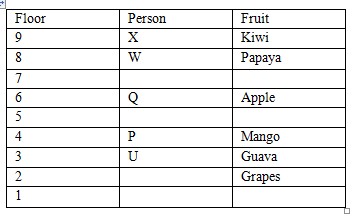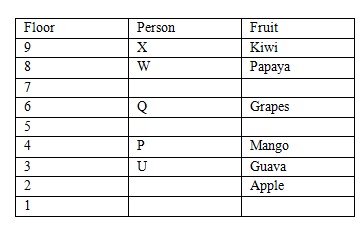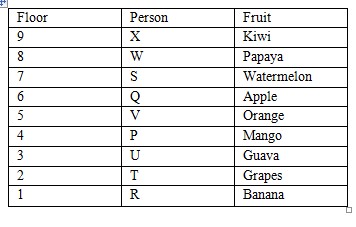Question
How many people live between the floors on which S and X
live? Study the following information carefully and answer the given questions: Nine people P, Q, R, S, T, U, V, W, and X live on different floors of a 9-floors building. Ground floor is numbered 1, first floor is numbered 2 and so on until the topmost floor is numbered 9. Each one likes different fruits i.e. Banana, Mango, Apple, Watermelon, Guava, Grapes, Orange, Papaya and Kiwi but not necessarily in the same order. V does not like Watermelon. U lives immediately below the one who likes Mango. Only one person lives between P and the one who likes Grapes. T lives immediately above R. Only two people live between Q and the one who likes Guava. W likes Papaya and lives on floor no. 8. The one who likes Banana does not live immediately above or immediately below Q. The one, who likes Mango, lives on an even numbered floor. The one, who likes Guava lives below the floor on which Q lives. S does not live immediately above or immediately below P. Only five people live above the floors on which P lives. X likes Kiwi fruit and lives immediately above W. Only three people live between the ones who like Grapes and Apple fruit. T does not like Apple.Solution
From the conditions, W likes Papaya and lives on floor number 8. Only five people live above the floors on which P lives. Only one person lives between P and the one who likes Grapes, it means the one who likes Grapes lives on either 2nd floor or 6th floor. Only three people live between the ones who like Grapes and Apple fruit. U lives immediately below the one who likes Mango. The one, who likes Mango lives on an even numbered floor, so only one place is left for the one who likes Mango now it is clear that P likes Mango. X likes Kiwi and lives immediately above W now it is clear that X lives on topmost floor. Only two people live between Q and the one who likes Guava. The one, who likes Guava lives below the floor on which Q lives. So there is only one possibility that Q will live on 6th floor. Case-1  Case-2
Case-2  T lives immediately above R. T does not like Apple, From this condition case-2 will be eliminated. Because in case-2 there is no places for T and R. Only case-1 will be continued with the remaining conditions. With the rest conditions, the one who likes Banana does not live immediately above or immediately below Q it means R likes Banana. S does not live immediately above or immediately below P so S will live on 7th floor. V does not like Watermelon so S will like Watermelon. It will be fixed that V lives on 5th floor and likes Orange. We will get final answer.
T lives immediately above R. T does not like Apple, From this condition case-2 will be eliminated. Because in case-2 there is no places for T and R. Only case-1 will be continued with the remaining conditions. With the rest conditions, the one who likes Banana does not live immediately above or immediately below Q it means R likes Banana. S does not live immediately above or immediately below P so S will live on 7th floor. V does not like Watermelon so S will like Watermelon. It will be fixed that V lives on 5th floor and likes Orange. We will get final answer. 
Price elasticity of supply of food products is generally
Which among the following is an aggregate fruit
Kisan Credit Card scheme was launched in which year?
To protect farmers from financial distress during crop failures, the government provides compensation through which of the following mechanisms?
A cross between a single cross hybrid and an inbreed {(A × B) × C} is
Which of the following scientists are credited with the discovery and understanding of the excretory role of Malpighian tubules in insects?
Given below are two statements:
Statement I: The transpiration, water is loss from aerial parts of plants in the form of invisible water vapours....
Farming systems that are based on the investment of capital in land and technology and operated with the intent of maximizing profits through large-scal...
How many kinds of genotypes are possible in F₂, if four genes are segregating independently?
Which of the following is used for disinfection measure in Mango?
Relevant for Exams:


